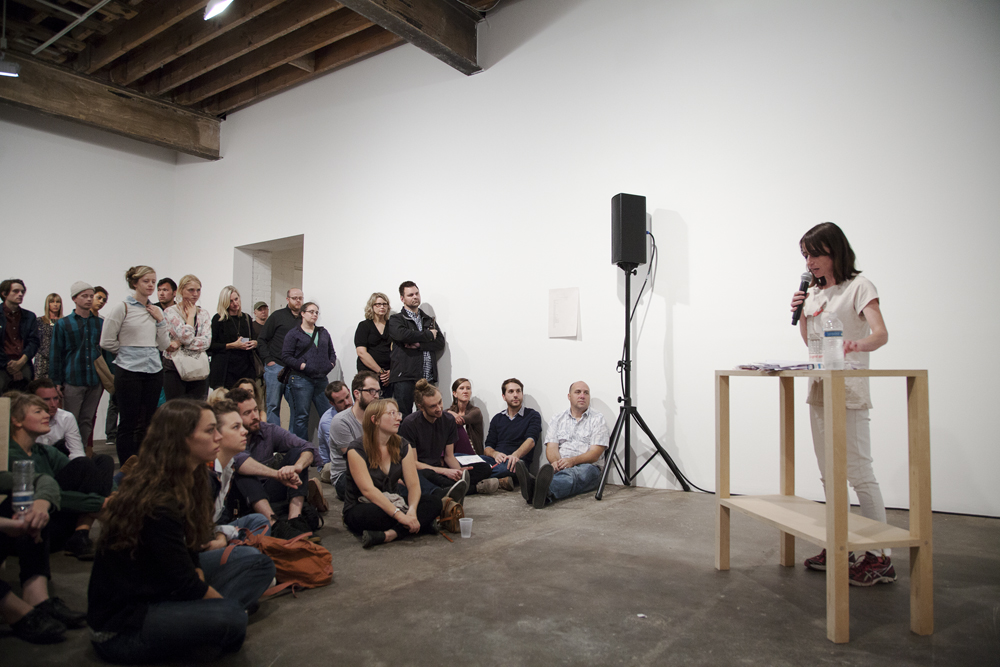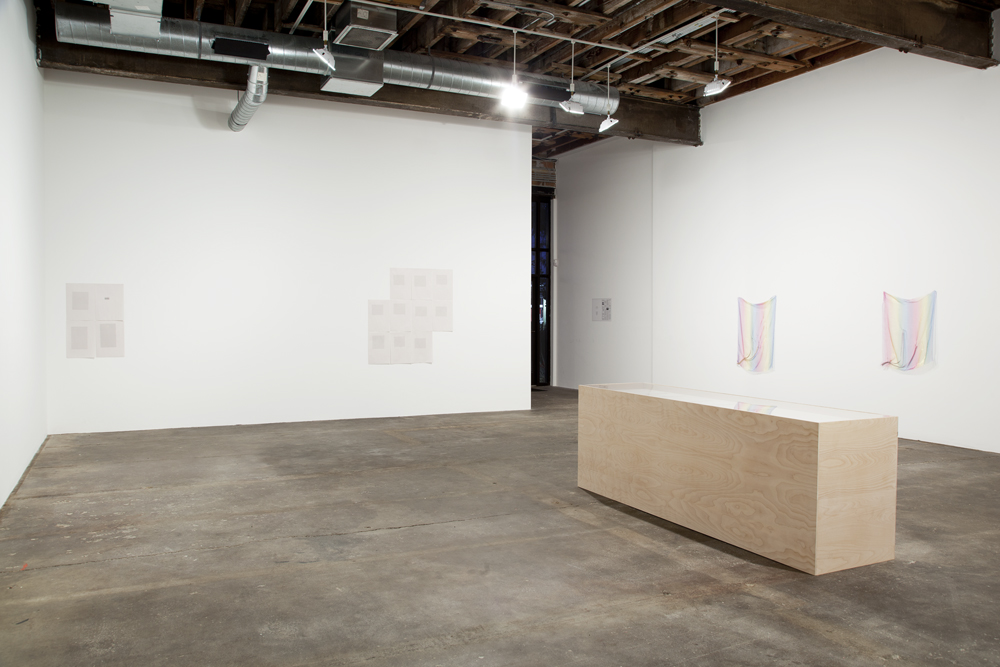The Password Effect
Writer Jay Orff parses the spoken word and visual arts experience of Glasgow-based artist Sue Tompkins' current exhibition at Midway, "Its chiming in Normaltown," on view through October 20.




MOUNTED ON THE GALLERY WALLS at Midway Contemporary Art are pieces of paper with scattered words and typographical marks, black on gray, some single pages, some pages arranged in blocks; the show is Glasgow-based artist Sue Tompkins’ Its chiming in Normaltown. The pages get a little lost on the large white walls, swimming in a sea of blankness. There is an unfinished wooden case in the middle of a room, within which are ripped, smaller pieces of paper (“there is something about ripping” says one of the full pages hung on the wall facing the case). We might expect to see something else presented like this, protected under glass: a rare manuscript, a first edition, a giant moth. But the case only holds spare sheets with sparse, but evocative typing.
On the walls, along with the sheets of paper, are several pieces of sheer fabric, delicate silk chiffon and organza, each one with a zipper indecorously safety-pinned to it. The zippers don’t bring together anything as they usually do, except maybe themselves; they are set free from their functionality, and they aren’t the kind of zippers one might find on chiffon gowns anyway. In the absence of evident purpose, we are left to appreciate the architecture of their modality. The sheets of paper and the pieces of fabric feel like stripped down forms, like shadows, skeletons.
The typed pages on the wall remind me of old teletype printouts; they have a 70s, early-computer, vaguely scientific aesthetic, but there’s something of the DIY in there, too — something rough and ready, the kind of project that results when one is desperate just to make something, with whatever is at hand. The words on the pages have that incidental feel about them too, as if what’s typed are bits of language grabbed while passing by. Some of the words are instructional (“America do the hustle”), some allusive (“in a galaxy far far away”), but much of the language is simply ambiguous, playful and despite the the words’ murky significance, somehow honest, too. I look around, and I trust everything I read — I believe the author, even if I don’t fully understand. And when language gives out, typographical marks continue to fill line after line, Xs and Os careening across the page — white noise interrupted by the occasionally recognizable word, perhaps “secular.”
Read one of the pages out loud, use them as a script, as Tompkins did in performance the night of the exhibition’s opening, and they start to come to life.
There used to be a TV game show called Password, in which one contestant would attempt to get their partner to figure out a secret word by saying other, related words intended to obliquely reveal it: contestants would say a word, give a hint, and look meaningfully at their partner; the one in the know would inevitably reiterate the original hint, but slowly, strangely, as if it could, so repeated, be newly revelatory.
“Trees. Treeeees. (imploring look) Treeeeeeees.”
There was something of this dynamic in the spoken word performance, LL Bedrock, created by Sue Tompkins to mark the opening of Its chiming in Normaltown at Midway. Tompkins has a history of musical performance (formerly in the band, Life Without Buildings). You could take this piece to be a sort of of post-modern rap, but although it may be a useful to consider her unaccompanied rhythmic free verse for LL Bedrock in light of LL Cool J and all the conventions of his form — I don’t think doing so is key to understanding the work here. Rock and roll allusions or not, Tompkins is doing something different.
The gallery crowd stands around her as she reads, reciting bits of displaced text, looking at us meaningfully between each phrase or utterance, like a contestant on Password — trying to connect, saying with her look, “Do you understand?” And smiling, always smiling, letting us know she was enjoying herself, and that we should enjoy ourselves, too. Some of what she utters are nonsense sounds but most of it is comprised of words — disconnected words, mostly spoken, some sung, often repeated in a way that makes you feel you mustn’t have understood and so the words are being repeated for your benefit. You sense that you are meant to understand what she is saying even if the words themselves are an inadequate vector for that understanding. “Doowop. Doowop. Doowop.” Tompkins steps back and smiles. We wait to see what happens next, entranced, wanting more. We do not offer any answers to her, and instead standing there mute, as we feel we’re supposed to.
______________________________________________________
I have this feeling that we who were listening shouldn’t have remained silent, like her soliloquy of disconnected sound and language could have been a game, if we’d dared to play along with her.
______________________________________________________
I have this feeling that we who were listening shouldn’t have remained silent. Maybe this could have been a conversation rather than a soliloquy of disconnected sound and language; it could have been a game, if we’d dared to play along with her.
Watching Tompkins’ piece, I was reminded of an article in the August 6 issue of New Yorker about Tino Seghal, whom writer Lauren Collins describes as using “the raw materials of voice, language and movement to build pieces of art.” This could serve as an apt description of Tompkins’ performance, as well. I felt I was witnessing — no, involved in a hybrid creation– one part reading, one part performance art, and one part dance. Tompkins uses slight movements — fidgeting and small gestures — to accent her spoken words; it seems the mirror reflection of the way words are sometimes used in contemporary dance pieces to punctuate a dancer’s movements. Tompkins was counting the beats between her utterances; it was a dance of words, a song of moving language, with indeterminate meaning, but which seems an important incantation all the same. And listening, I found myself glad to hear her doing it, for all of us.
Notably, Tompkins doesn’t make the performance available online, although it was taped for Midway’s archives (and you can find some similar clips on YouTube to get a sense of what she does). You can’t watch her performance of that evening, though, and I think that fact serves as a fitting reminder of the fundamental difference between the immediacy of live performance — standing in the gallery for 45 minutes watching someone navigate sound and meaning — and sitting at home, watching such work via online media, pausing the video stream occasionally to get a snack. These two are not the same experiences; indeed, something vital would be lost in translation. Tompkins’ performance is about interaction, about the dynamic between the speaker and the listener, about trying to connect and disconnection, about hope and the hopeless, about the human voice playing on a human ear in real time.
For the opening, Tompkins read from a collected script that packed a thick, three ring binder; she turned page after page, after bit of paper, as she read. I wished the walls of Midway could have been covered, top to bottom, with those pages, and the ceiling, and the floor, too. Hearing her delightful performance, I wanted more. I wanted to get lost in the noise of her words, physically to wander through them. And perhaps this desire, this missing space, is an intended effect; perhaps these examples are just that, examples, an invitation to more. Maybe they’re her greatest hits hinting at the larger body of work.
I left the gallery after her performance attuned to the sounds around me. A homeless man was on the street, repeating the word “mine” and pointing at his back. “Mine. Mine. Mine.” He was accompanied by the wash of traffic –“Shhh, shhhhhhhhh, shh” — plus, the electronic voice of the crosswalk regulator, “Wait…wait…wait.” I stopped in a nearby grocery store, where a woman stood in front of the meat case, pleading into her cell phone, “I don’t know what kind of sausage to get. I don’t know what kind of sausage to get. Links or patties? I don’t know what kind of sausage to get. Links or patties?”
I was swimming through a sea of repeated, rhythmic, insistent, disconnected, and desperate language, ignoring what I could, but also trying to figure out what, if anything, it might mean.
______________________________________________________
Related links and information:
Sue Tompkins: Its chiming in Normaltown is on view at Midway Contemporary Art through October 20. The noted performance of LL Bedrock took place in the gallery, at the exhibition’s opening reception, September 7, 2012. For gallery hours and additional information: http://www.midwayart.org.
______________________________________________________
About the author: Jay Orff is a writer, musician and filmmaker living in Minneapolis. His fiction has appeared in Reed, Spout, Chain and Harper’s Magazine. Read more on www.jayorff.com.